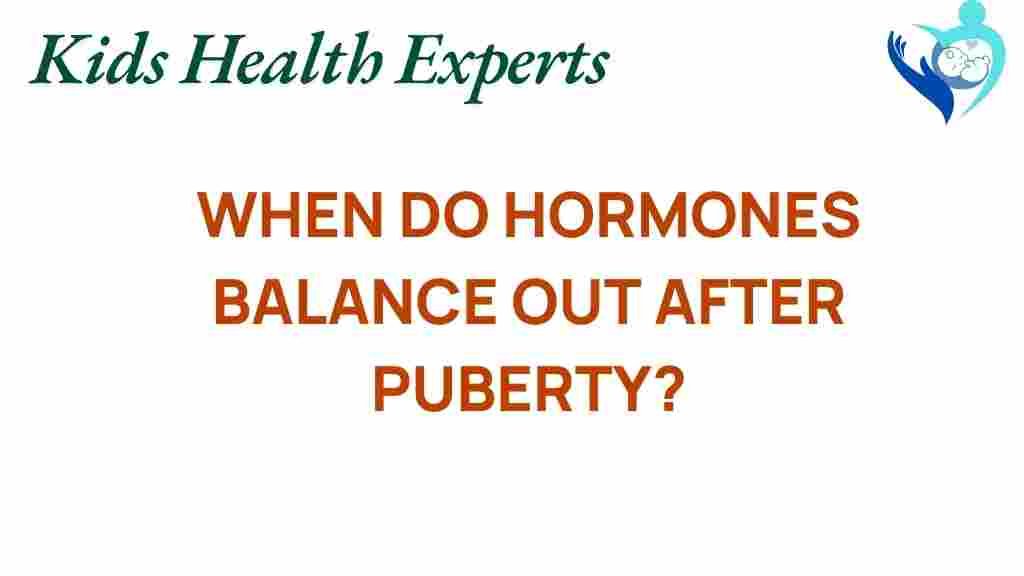Unraveling the Mystery: When Do Hormones Truly Balance After Puberty?
The journey through puberty is a transformative period marked by significant biological changes that affect both physical and emotional well-being. During this time, the endocrine system plays a crucial role by releasing hormones that influence growth, development, and mood. As adolescents navigate these changes, understanding when hormones achieve balance after puberty is essential for maintaining health and well-being.
Understanding Hormones and Puberty
Hormones are chemical messengers produced by the endocrine system that regulate various bodily functions. Puberty typically begins between ages 9 and 14 and lasts several years. It is a time of rapid growth, sexual maturation, and emotional development. Key hormones involved in this process include:
- Estrogen: Primarily responsible for female sexual development.
- Testosterone: Drives male sexual characteristics and muscle growth.
- Growth Hormone: Influences growth and development during adolescence.
- Thyroid Hormones: Regulate metabolism and energy levels.
These hormones fluctuate significantly during puberty, leading to various physical and emotional changes. Understanding how these hormones interact can provide insight into when balance is typically achieved.
The Timeline of Hormonal Changes During Adolescence
Adolescence is characterized by a series of hormonal shifts that can be categorized into three main phases:
- Early Adolescence (Ages 9-12): Hormonal changes begin, signaling the start of puberty. Estrogen and testosterone levels rise, leading to the development of secondary sexual characteristics.
- Middle Adolescence (Ages 13-15): Hormonal fluctuations peak, causing significant growth spurts, emotional turbulence, and the full onset of secondary sexual characteristics.
- Late Adolescence (Ages 16-19): Hormonal levels begin to stabilize, and physical growth slows. Emotional development continues as individuals transition into adulthood.
During these phases, individuals may experience a wide range of emotions due to the constant changes in hormone levels. Understanding this timeline is crucial for recognizing when hormonal balance may begin to occur.
Biological Changes and Their Impact on Health
The biological changes associated with puberty can have lasting effects on health and emotional well-being. These changes include:
- Physical Growth: Increased height and muscle mass, particularly in males.
- Body Composition Changes: Shifts in fat distribution and muscle development.
- Menstrual Cycle Regulation: For females, the establishment of a regular menstrual cycle is a key indicator of hormonal balance.
- Mood Swings: Fluctuations in hormones can lead to increased irritability, anxiety, and mood swings.
As individuals progress through adolescence, they may also face challenges related to self-esteem, body image, and social relationships, all influenced by hormonal changes. Recognizing these impacts can help in managing emotional well-being during this critical period.
When Do Hormones Achieve Balance After Puberty?
After the tumultuous years of puberty, many wonder when hormones truly achieve balance. Here are some key points to consider:
- Age of Stability: Hormonal balance is generally observed in the late teens to early twenties. By this stage, the body has adapted to the changes initiated by puberty.
- Factors Influencing Balance: Genetics, lifestyle, nutrition, and overall health can significantly influence the timeline for achieving hormonal balance.
- Menstrual Cycle Regulation: In females, the regularity of the menstrual cycle can indicate hormonal balance and overall reproductive health.
While some individuals may experience a quicker return to hormonal balance, others may take longer, and this variation is normal. Understanding these differences can help in managing expectations during this period of development.
Signs of Hormonal Imbalance During and After Puberty
It is important to recognize the signs of hormonal imbalance, which can manifest in various ways:
- Physical Symptoms: Severe acne, irregular periods, weight gain, or loss.
- Emotional Symptoms: Persistent anxiety, depression, mood swings, or irritability.
- Developmental Concerns: Delayed growth or sexual development may indicate an underlying hormonal issue.
If any of these symptoms persist, it is advisable to consult a healthcare professional for evaluation and potential interventions.
Troubleshooting Hormonal Imbalance
For those experiencing hormonal imbalances during or after puberty, several strategies can help restore balance:
- Healthy Diet: Consuming a balanced diet rich in vitamins, minerals, and healthy fats can support hormonal health.
- Regular Exercise: Physical activity helps regulate hormone levels and boosts overall health.
- Stress Management: Techniques such as mindfulness, meditation, and yoga can help mitigate stress and its impact on hormonal balance.
- Sleep Hygiene: Ensuring adequate and quality sleep is crucial for hormone regulation.
In some cases, medical intervention may be necessary. Hormonal therapy or medications may be recommended by healthcare providers to address specific imbalances.
Conclusion
Understanding when hormones achieve balance after puberty is crucial for maintaining health and emotional well-being throughout adolescence and into adulthood. The journey through puberty is marked by complex biological changes driven by the endocrine system, and while hormonal balance may not occur until late adolescence or early adulthood, recognizing the signs of imbalance can lead to proactive management strategies.
By focusing on healthy lifestyle choices, individuals can foster an environment conducive to hormonal balance, paving the way for a smoother transition into adulthood. If concerns about hormonal health arise, seeking guidance from healthcare professionals is always a prudent choice.
For more information on hormones and their impact on health, consider visiting this resource. Additionally, if you’re looking for support during adolescence, check out this helpful guide.
This article is in the category Conditions and created by KidsHealthExperts Team

2 thoughts on “Unraveling the Mystery: When Do Hormones Truly Balance After Puberty?”